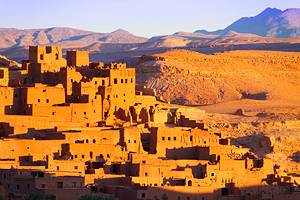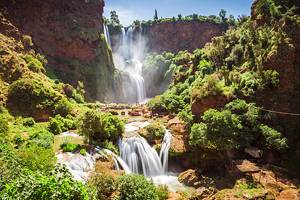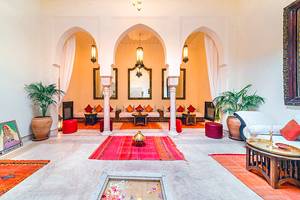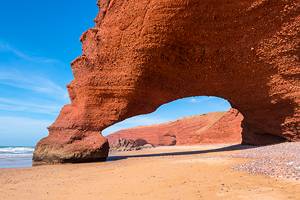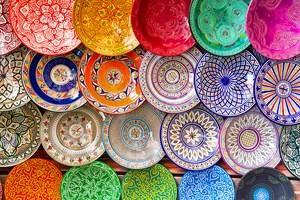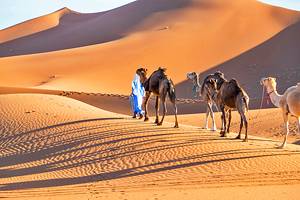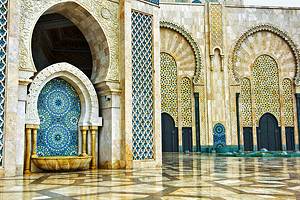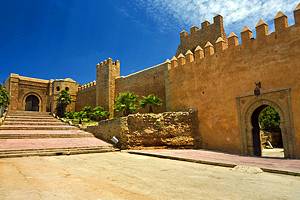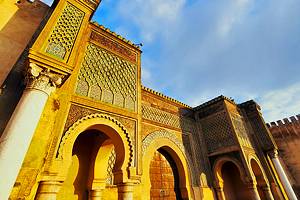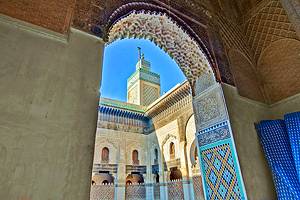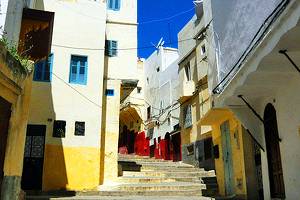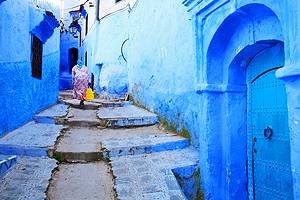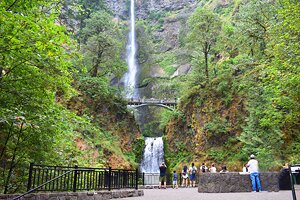17 Top-Rated Attractions & Places to Visit in Marrakesh
Marrakesh is a city that effortlessly combines the ancient and the new. The city's name provided the root for the name of the country itself, spelling out this town's importance through the ages.
Within the high red walls of the medina, just soaking up the atmosphere is the main tourist attraction with snake charmers and smooth shop touts both competing for your attention amid a noisy, colorful bustle that encapsulates Morocco's vibrant soul.
For shoppers, Marrakesh's souqs are the best place to visit in Morocco, offering the full scope of the country's artisan work, while the medina's scatter of richly decorated heritage buildings are some of the country's most famous monuments.
Marrakesh is also the gateway into the High Atlas region, Morocco's major activity area, with hiking, mountain biking, climbing, and many other active things to do. Even on a short visit, you can experience a taste of Morocco's mountain life on one of the many Marrakesh day trips offered from the city.
Discover what the city has to offer with our list of the top attractions and things to do in Marrakesh.
- 1. Shop the Medina Souks
- 2. Experience Djemaa El Fna After Dark
- 3. Stay in a Medina Riad Hotel
- 4. Admire the Koutoubia Mosque
- 5. Stroll around Majorelle Gardens
- 6. Visit the Medersa Ben Youssef
- 7. Soak in a Hammam
- 8. Be Dazzled by Bahia Palace
- 9. Hot-Air Balloon Ride Over the Marrakesh Countryside
- 10. Cycle or Horse Ride in the Palmeraie
- 11. Check Out the Saadian Tombs
- 12. Visit Dar Si Said
- 13. Admire the Interiors of Marrakesh Museum
- 14. Explore the Badi Palace
- 15. Peek into the Almoravid Koubba
- 16. Picnic in Manara Gardens
- 17. Photograph the Marrakesh Tanneries
- Where to Stay in Marrakesh for Sightseeing
- Tips and Tours: How to Make the Most of Your Visit to Marrakesh
- Map of Attractions & Things to Do in Marrakesh
- History of Marrakesh
1. Shop the Medina Souks
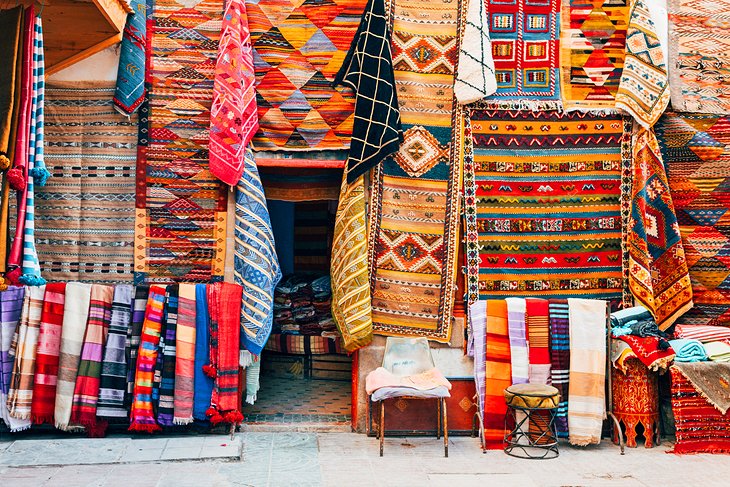
For many visitors, Marrakesh's labyrinthine medina (old city) district is the town's star attraction.
The narrow alleyways are a kaleidoscope of colors, scents, and sounds and are bound to be the sightseeing highlight of your trip.
As well as simply wandering (and getting lost) amid the bustling maze, there are myriad shopping opportunities where you can put your haggling hat on and barter to your heart's content.
The main souq area is the tangle of lanes between Place Rahba Kedima and Place Ben Youssef.
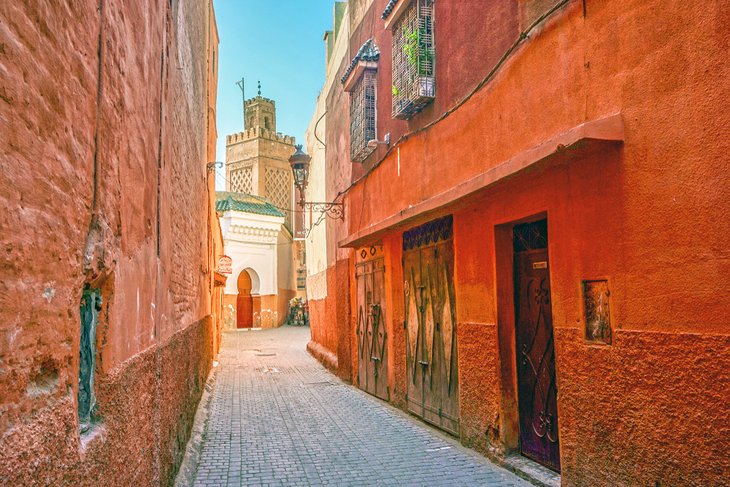
Just off Place Ben Youssef, you'll find Fondouq Namas, an old trader caravanserai that is now home to plenty of carpet shops. Place Rahba Kedima itself is one of the main medina areas for buying spice and spice mixes.
Souq Haddadine is the metalworkers area, while just to the north is Souq Cherratine, where the leatherworkers have their workshops.
The narrow crisscross of lanes between the main thoroughfares of Souq el-Kebir and Souq Smata is full of traditional clothing stalls, while if you follow Souq Lebbadine west, you'll end up amid the skiny alleys of Souq Teinturiers (the Dyers souq).
2. Experience Djemaa El Fna After Dark
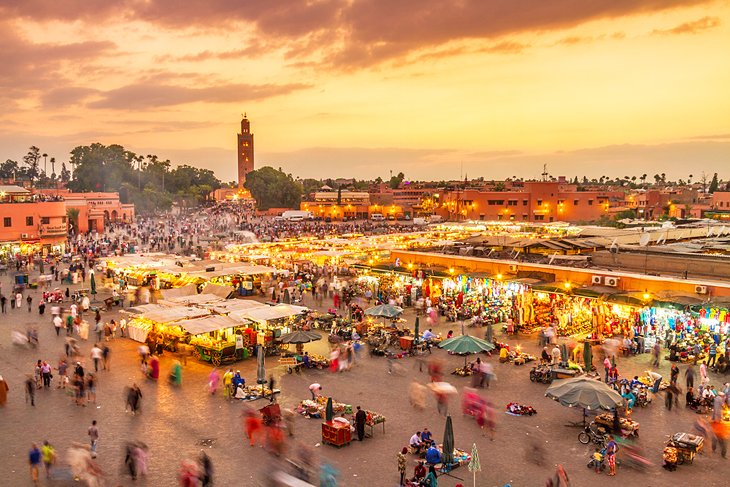
This large square at the entry to the medina is the center of Marrakesh life.
The Djemaa El Fna (assembly place of the nobodies) is a vibrant hub of bric-a-brac stalls, musicians, storytellers, fortune-tellers, and snake charmers that springs into life from late afternoon daily with entertainment carrying on until midnight.
An evening spent here wandering between the acrobat troupes and local musical groups is a truly Moroccan experience.
At sunset, the northern section of the square fills with stalls serving cheap meals and snacks. It's also easy to escape the chaos of the square for a time-out at one of the many cafés that rim the square. Many of these cafés also offer the best panoramic views of all the Djemaa El Fna action from their rooftops.
Address: Avenue Mohammed V, Marrakesh
3. Stay in a Medina Riad Hotel
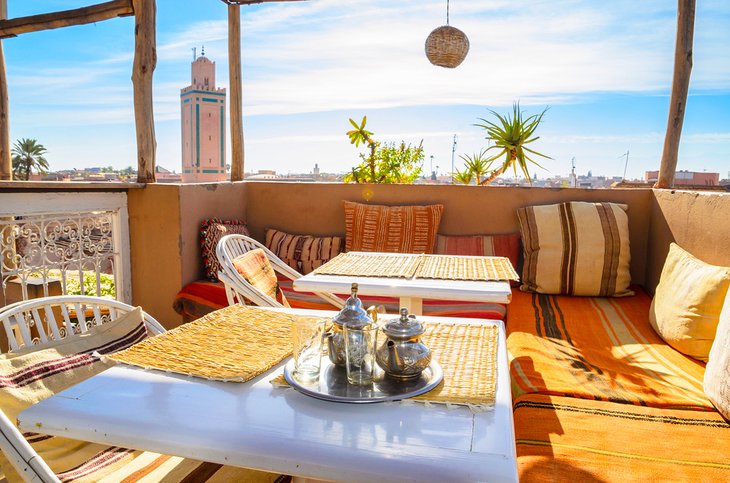
Marrakesh's riad hotels are an experience in themselves, and for many travelers, a visit here is as much about the hotel as it is about the city.
A riad is a traditional medina mansion, centered around a courtyard. Over the past few decades, many have been restored, revamped, and opened as boutique hotels, usually in the luxury and mid-range category (though Marrakesh even has a backpacker hostel based in a restored riad).
Some are palatial in both historic ambience and their Moroccan artisan features, while others blend contemporary style with traditional design.
Modern comforts and amenities such as plunge pools and on-site hammams (Turkish baths) are common in the larger riads, and many also provide evening meals on request.
4. Admire the Koutoubia Mosque
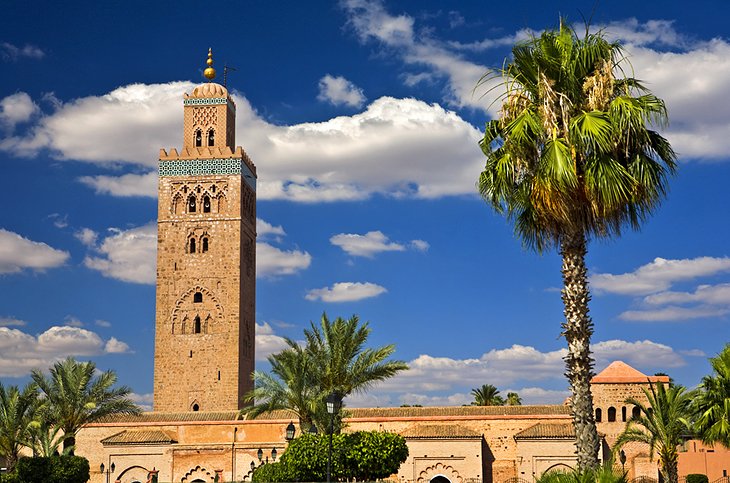
The Koutoubia Mosque is Marrakesh's most famous landmark with its striking, 70-meter-tall minaret visible for miles in every direction.
Local Marrakesh legend tells that when first built, the muezzin (man who calls the faithful to pray) for this mosque had to be blind, as the minaret was so tall, it overlooked the ruler's harem.
The mosque was built in 1162 and is considered one of the great achievements of Almohad architecture.
The archaeological excavation area on the northwest side of the minaret displays the foundations of the earliest mosque built on this site. It was destroyed by the Almohads and replaced with the current mosque.
Non-Muslims are not allowed into the Koutoubia Mosque itself.
Address: Avenue Mohammed V, Marrakesh
5. Stroll around Majorelle Gardens
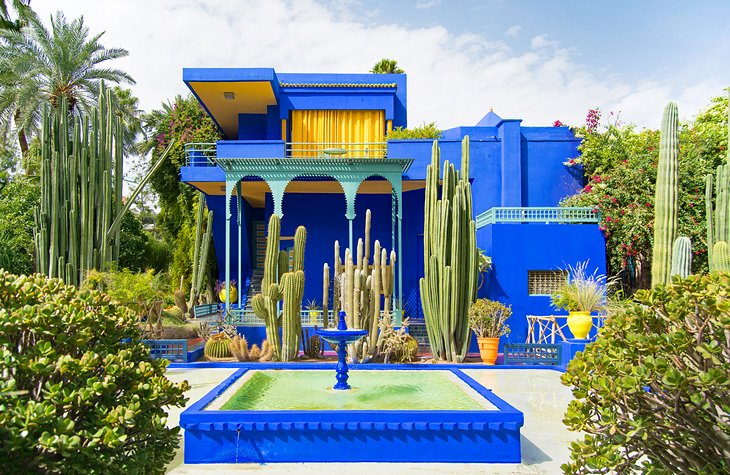
These lush tropical gardens full of cacti, palms, and ferns, are the work of painter Jacques Majorelle.
Originally from the town of Nancy in France, Majorelle came to Marrakesh for health reasons and became well known for his paintings of local Moroccan life.
His most famous work, though, was this garden and the vibrant blue (the color now known as Majorelle blue) painter's studio he lived in on the grounds.
After Majorelle's death in 1962, French fashion designer Yves Saint Laurent bought the property, and upon his death in 2008, his ashes were scattered in the gardens.
Within the grounds, Majorelle's old painting studio is now home to a fabulous museum dedicated to Berber artistry.
Just next door to the entrance into the gardens is a museum dedicated to the life and fashion legacy of Yves Saint Laurent, which also hosts a program of temporary exhibitions.
Address: Avenue Yacoub el Mansour, Marrakesh
6. Visit the Medersa Ben Youssef
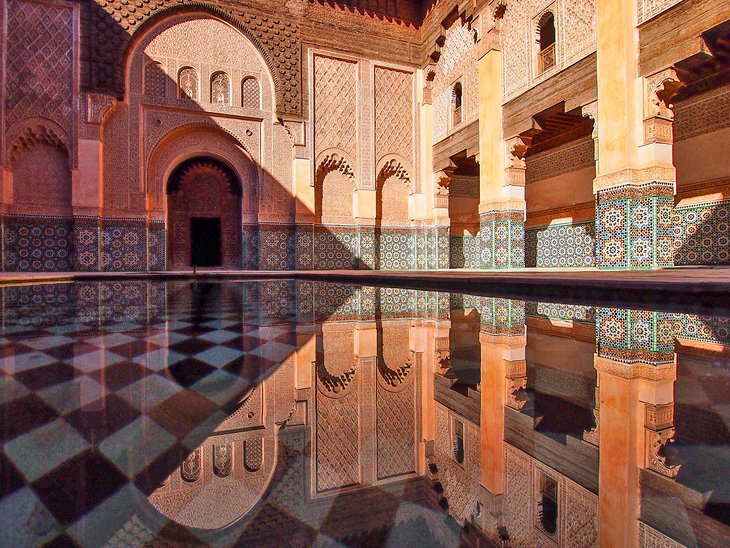
The sumptuously decorated Medersa of Ben Youssef is one of the finest examples of Saadian era artistry in Morocco. This theological college (completed in 1565), directly opposite the Ali Ben Youssef Mosque, once homed 900 students and was the largest center for Quranic study in the country.
The warrens of rooms where students once slept are clustered around small internal courtyards in typical Islamic architecture style, but the main internal courtyard is the real highlight here.
The fine zellige tiling, stalactite ceilings, cedar-wood detailing, and Kufic inscriptions used as decoration across the courtyard's interior make this medersa one of Morocco's most beautiful buildings and a star medina attraction.
7. Soak in a Hammam
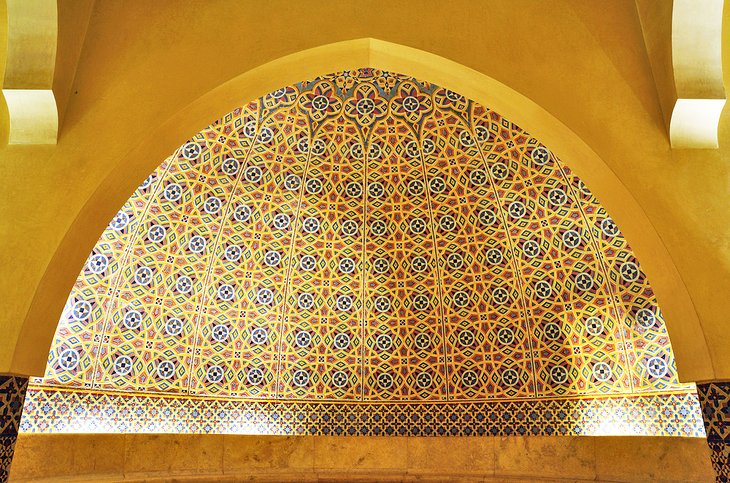
Navigating around the medina can be hot, dusty, and crowded work but luckily there's a traditional way to relax and rejuvenate after your sightseeing and shopping is done.
A hammam is a traditional communal bath (often called a Turkish bath) with a multiple domed interior dedicated to bathing. The process at its most basic consists of steaming, washing, and then exfoliating your skin, with a short massage as an additional service.
While public hammams are scattered throughout the medina and still serve the community, many historic and contemporary-built hammams provide hammam experiences directly aimed at visitors and are a great introduction to Moroccan hammam culture.
Some of the more luxurious hammams also provide modern spa add-ons with a host of beauty treatments and massages available.
8. Be Dazzled by Bahia Palace
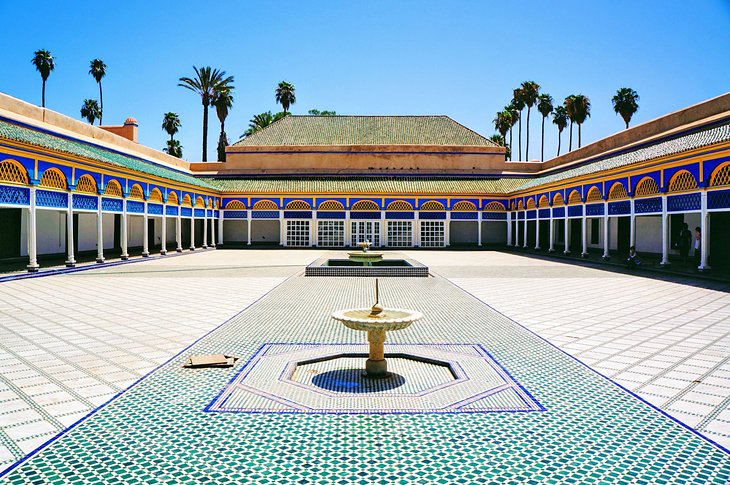
This magnificent peacock of a palace was built in the late 19th century as the residence of the Grand Vizier Bou Ahmed, who served Sultan Moulay al-Hassan I.
The interior decoration is a dazzling display of Moroccan artisan work combining zellige tiles, painted ceilings, and ornate wrought-iron features showcasing the opulent lives of those high up in the sultan's favor at that time.
The massive marble grand courtyard and opulent salons of the haram area are the two main attractions, while the lush internal courtyard of the grand riad, with its banana-leaf plants and citrus trees, is a tranquil respite from the city.
Address: Rue Riad Zitoun el Jedid, Medina, Marrakesh
9. Hot-Air Balloon Ride Over the Marrakesh Countryside
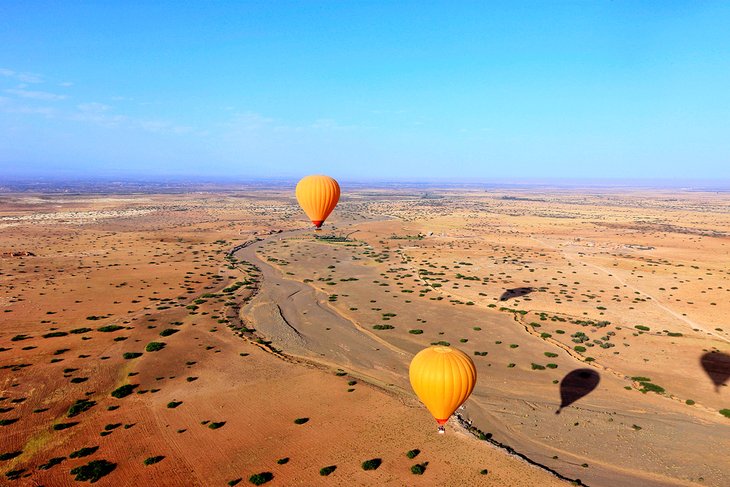
Several companies run sunrise hot-air balloon ride tours in Marrakesh, which provide panoramic views across the city, the palm groves, and surrounding arid plateau and the spine of the Atlas Mountains in the distance beyond.
For photographers, the dramatic vistas are definitely worth the early-morning start.
Flights generally take off just after sunrise and usually include an hour of flight time with a picnic breakfast of traditional Berber dishes offered after the flight, and return transfers to the city center.
Higher priced tours often include a camel ride or quad bike tour after the hot-air balloon ride or offer private baskets rather than sharing the balloon basket with other passengers.
10. Cycle or Horse Ride in the Palmeraie
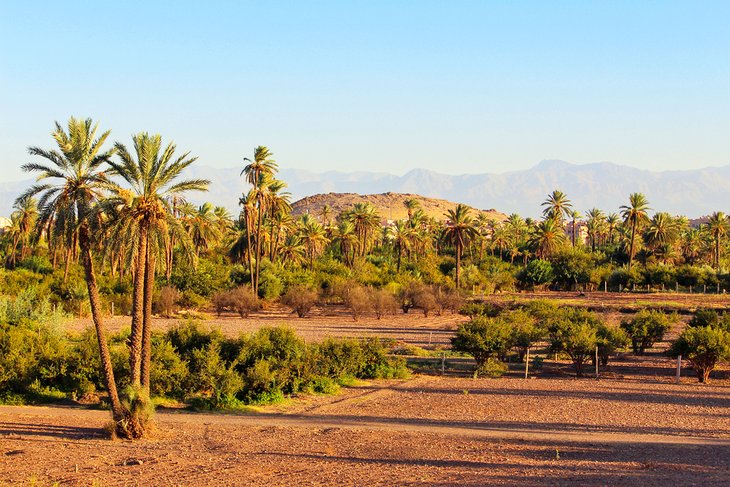
Marrakesh's Palmeraie (palm groves) area is just to the northwest of the city.
Containing around 50,000 date palm trees, the palmeraie is an alternative to staying in central Marrakesh, with plenty of villa-style luxury boutique hotels.
If you are not staying in the palmeraie, though, you can still enjoy a time-out from the city in this tranquil, shady haven as it's a popular destination for cycling, horse riding, and quad-bike tours, as well as camel rides.
Palmeraie half-day cycle tours are offered by a couple of local companies and thoroughly cover the area, while Palmeraie-based stables offers horse rides that explore both the palmeraie and some of the surrounding countryside.
11. Check Out the Saadian Tombs
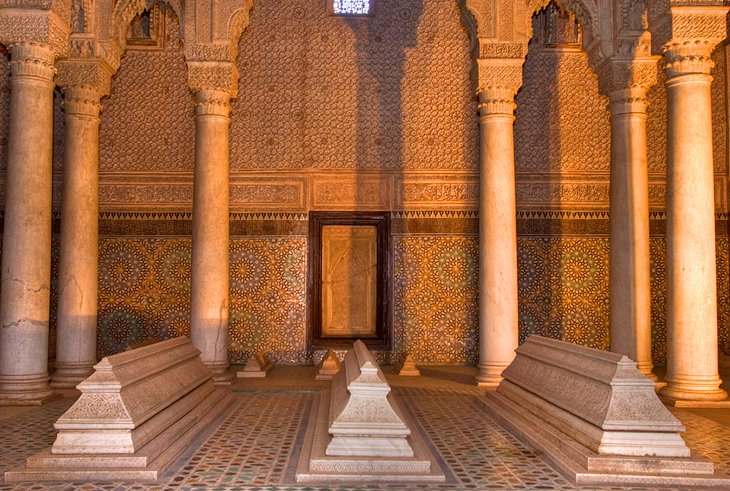
This 16th-century burial ground is home to 66 members of the Saadian dynasty, which ruled over Marrakesh between 1524 and 1668.
The tombs here include that of the ruler Al-Mansour, his successors, and their closest family members.
It's a rambling, atmospheric place, with the mausoleums set amid a rather overgrown garden.
In particular, the main mausoleum (where Moulay Yazid is buried) has a fine surviving mihrab (prayer niche).
The Saadian Tombs were walled up by their Alawite successors and were only rediscovered in the early 20th century.
The entrance to the Saadian Tombs is the small alleyway next to the southern wall of the Kasbah Mosque.
Address: Rue Kasbah, Medina, Marrakesh
12. Visit Dar Si Said
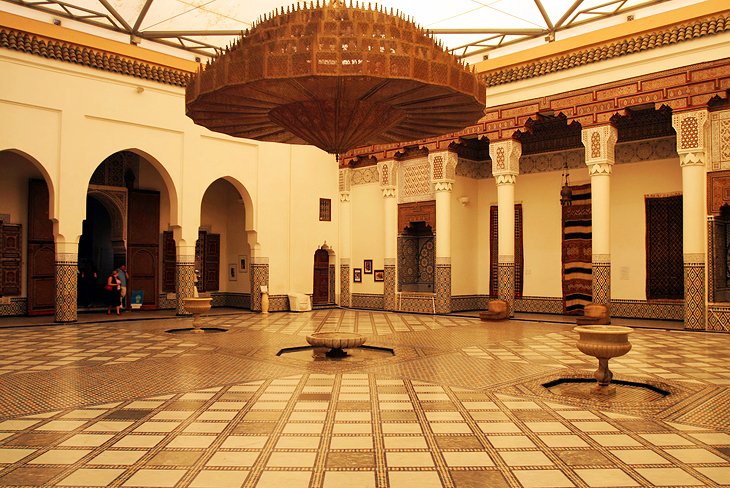
This lovely old palace built by Vizier Si Said is home to a wonderful collection of Berber jewelry in finely worked silver, oil lamps from Taroudant, pottery artifacts, embroidered leather, and marble.
There is also a display of Moroccan carpets and an amazing collection of traditional Moroccan door and window frames, which highlight this country's local architecture styles.
For anyone interested in the evolution of North African art and crafts, it's a lovely place to potter about for a couple of hours.
Near the Dar Si Said, the Maison Tiskiwin has a rather wonderful collection of costumes, jewelry, arms, musical instruments, textiles, and furniture (focused on Saharan culture) put together by Dutch art historian Bert Flint. Another branch of the museum is in Agadir.
Location: Off Rue Riad Zitoun el Jedid, Medina, Marrakesh
13. Admire the Interiors of Marrakesh Museum
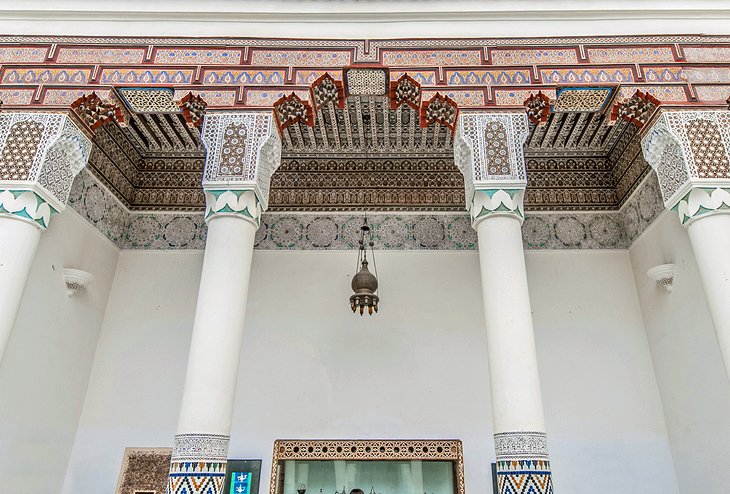
The Marrakesh Museum (Musee de Marrakech) has an eclectic collection ranging from contemporary art to Qur'anic inscriptions, with local ceramic work, textiles, and coins thrown in for good measure.
For most visitors, the real highlight of a visit here, though, is the building itself.
The museum is housed in the Mnebhi Palace, which was originally the residence of Mehdi Mnebhi (a minister in Morocco's government) but was later home to Pasha Thami Glaoui, ruler of Marrakesh.
The architecture is a harmonious blend of local North African form with Portuguese elements, and features an extremely impressive central courtyard area complete with a lavish chandelier.
Address: Place Ben Youssef, Medina, Marrakesh
14. Explore the Badi Palace
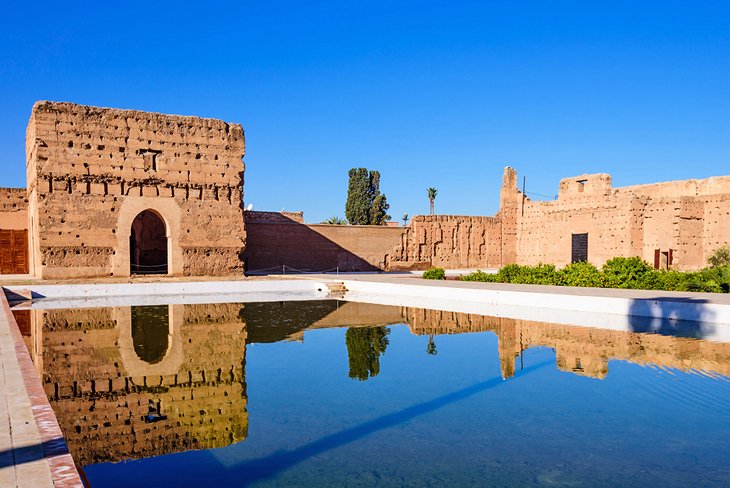
The ruins of Al-Mansour's once grand palace are one of the kasbah area's most atmospheric sights. The Saadian ruler built the opulent palace, with pavilions set amid a mammoth garden of reflective pools, during his triumphant reign, but it was plundered and destroyed soon after.
Now the sparse remnants of mosaic-tiled floors, ruined pavilions, and the high enclosing walls are all that remain. There are excellent views across the medina from the top of the walls, where storks have also built their nests.
After viewing the palace, head to the nearby Mellah, the old Jewish quarter of Marrakesh. It was established in the 16th century and is now populated mainly by Muslims.
The small synagogue here has been nicely restored and can be visited, as can the vast Jewish cemetery.
15. Peek into the Almoravid Koubba
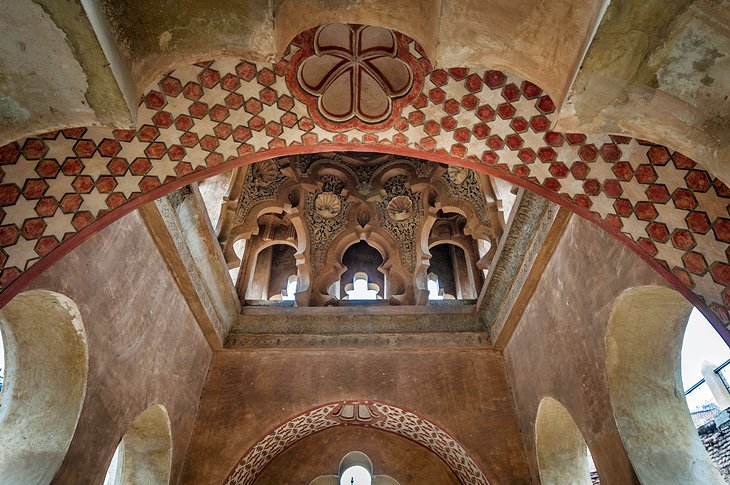
Also known as the Koubba Ba'adiyn, the Almoravid Koubba is Marrakesh's oldest monument still standing, built in the 12th century during Ali Ben Youssuf's reign.
Although its original use is unknown, some experts have suggested that it may have been the ablution house of a mosque that once sat next door.
Its simple exterior design (a squat, square building topped with a dome) belies an interesting interior, with a dome ceiling covered in Almoravid motifs.
The koubba was one of the few buildings to survive the damage inflicted by the Almohad conquerors, who destroyed much of the earlier Almoravid architectural legacy.
Address: Place Ben Youssef, Medina
16. Picnic in Manara Gardens
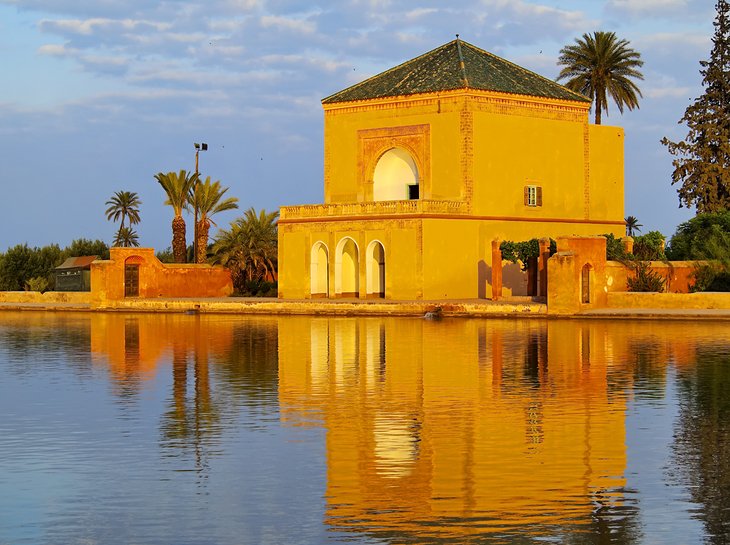
This huge garden, once a royal retreat, is a bubble of serenity hidden right in the heart of Marrakesh. It's a favorite spot for locals who want to escape the hustle and enjoy some peace and quiet.
The majority of the area is taken up with olive groves, but for visitors, the main attraction and reason to come here is the large reflective pool with its fine pavilion. Built in the late 19th century, the pool and pavilion are a favored spot for many local Marrakesh families, who come here to picnic and stroll.
There are excellent photo opportunities here of the pool with the Atlas Mountain Range reflected in its water, on a clear day.
Address: Avenue Menara, Marrakesh
17. Photograph the Marrakesh Tanneries
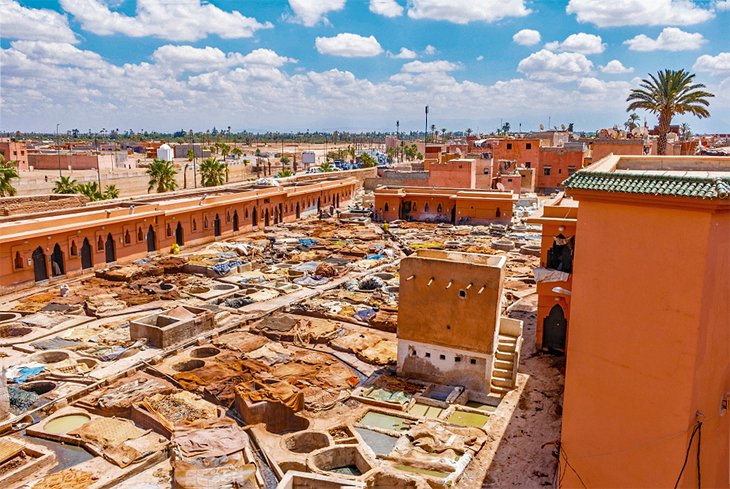
Marrakesh's tanneries district is smaller than the one in Fes but just as atmospheric. This is where the leather hides, used for the colorful shoes, bags, and other products you'll find in the souks, get dyed in a myriad of shades.
Come here in the morning if you want to see the tanners working in the colored vats of dye.
For photographers, there are great views over the entire area from some of the leather workshops, which rim the tanneries. You need to pay the shop a tip to enter and head up to their balconies or rooftops, and do expect the staff to try to get you to linger and buy something.
Address: Rue Bab Debbagh, Marrakesh
Where to Stay in Marrakesh for Sightseeing
If you're visiting Marrakesh for the first time, and want to be in the heart of the action, the best area to stay is in the medina, near the Djemaa El Fna, the large square at its entrance. Some of the best-value accommodation options here are riads, traditional Moroccan guesthouses with inner courtyards that are shielded from the hustle and bustle of the medina outside; breakfast is usually included in the price.
Luxury Hotels:
- Oranges and rose blossoms perfume the air at La Villa des Orangers, steps away from all the medina attractions and the Koutoubia Mosque. This is a Relais & Châteaux property, with three patios, a rooftop pool, and a spa with a hammam.
- In the medina, near the entrance to the old souk, Riad Dar Anika is a more affordable luxury option, with a lovely courtyard pool and warm Moroccan hospitality.
- If you prefer to stay away from the hubbub of the medina, the Four Seasons Resort Marrakech is a taxi ride away. Facilities include palm-lined pools, a spa, fitness center, and kids' club.
Mid-Range Hotels:
- In the heart of the medina, the evocatively-named Riad Romance resides in a restored 17th-century building, with a lovely courtyard pool, cozy rooms, and a rooftop garden.
- Also in the medina, Dar Charkia, with a heated swimming pool, is in the Dar el Bacha antique dealers district. All the rooms are air-conditioned, and many come with a fireplace.
- Riad Karmela is a soothing oasis amid the medina, with a spa, restaurant, and personalized service. With its family apartments, it's a great choice for those traveling with kids.
Budget Hotels:
- In the medina and with a pool, Riad Sadaka has comfortable and cozy rooms and serves up tasty Moroccan cuisine, while Riad L'Orchidee has air-conditioned rooms, a plunge pool, and plenty of inviting nooks for relaxing and dining.
Tips and Tours: How to Make the Most of Your Visit to Marrakesh
Taking an organized tour is a great way to see all the highlights of Marrakesh and the Atlas Mountains and experience the traditional culture without the hassle of finding your way around. Along the way, you'll learn all about the area's history, as well as insider tips and stories. These tours also include convenient pickup and drop-off at select hotels.
- Full-Day City Sightseeing Tour: The Marrakesh Discovery Tour allows you to relax and enjoy the sights while a local guide takes you on a tour through the city's labyrinthine backstreets and bustling souks, as well as historical highlights such as Bahia Palace and the Koutoubia Mosque. This full-day tour includes lunch at a medina restaurant, entrance fees, and pickup and drop-off from select hotels.
- Half-Day City Sightseeing Tour: Alternatively, the Marrakesh Half-Day Private City Tour offers three to four highlights of the city with stops at Majorelle Gardens, Bahia Palace, and the Saadian Tombs followed by a medina walking tour. Transport is included.
- Small-Group Atlas Mountains Day Trip: The Four Valleys Day Trip from Marrakech with Optional Visit to Takerkoust Lake and Kik Plateau is the perfect complement to a hectic city stay. This full-day tour gives you a great overview of the Atlas mountains, with a visit to three lush valleys, traditional Berber villages, Ourika Valley waterfalls, an optional lunch in a Berber home, and an optional upgrade to include the Takerkoust Lake and Kik Plateau. This is a small-group tour with more personalized service and a maximum of seven people.
- Toubkal National Park Day Trip: The Atlas Mountain Three Valleys Day Trip is a private full-day tour of the beautiful scenery in and around Toubkal National Park, with an included lunch and visit to a traditional Berber home. As well as all transport being included, with pickup and drop-off from Marrakesh hotels, the tour itinerary includes a short hike (or mule ride) from Imlil to the tiny mountain village of Ait Souka, a visit to an argan oil cooperative, and a camel ride.
- Hot Air Balloon Ride: The Atlas Mountains Hot Air Balloon Ride offers a different perspective on the desert and Atlas Mountain foothill scenery surrounding Marrakesh. On this morning adventure, you take a hot air balloon ride for bird's-eye views. Afterwards, descend to ground level for a delicious Berber breakfast and a camel ride in Marrakesh's Palmeraie. Also included is a flight certificate, as well as pickup and drop-off from select hotels.
- Camel Ride: The Sunset Camel Ride is a great way to explore the sandy trails of Marrakesh's Palmeraie area, shaded by date palms as you ride. The ride takes around one hour and ends at a traditional Berber house with included mint tea and snacks. Pickup and drop-off from Marrakesh hotels is included.
Map of Attractions & Things to Do in Marrakesh
History of Marrakesh
The Almoravides made Marrakesh the capital of an empire that covered most of the Maghreb (Northwest Africa) and extended well into Europe.
With the Almoravide conquest of southern Spain, Marrakesh was invested with the cosmopolitan culture of Andalusia and became a bastion of Islamic civilization and an intellectual center where the most famous scholars and philosophers of the age converged.
Lavish buildings were constructed and splendid gardens designed. The ancient ramparts and gates of the city are monuments to its medieval preeminence.
Almohade armies stormed the gates of Marrakesh on March 23, 1147, conquering the Almoravide capital.
The Almohades under Abdal Mou'min continued their conquest of North Africa, extending their empire through Algeria and Tunisia and moving across the Mediterranean to capture Seville, Cordoba, and Granada. Under Abdal Mou'min, Marrakesh became an even greater Islamic capital.
Marrakesh went into a period of decline under the Merenids, who captured the city in 1269. The Merenid capital was already centered in Fes, and Marrakesh fell into neglect for two and a half centuries.
The fortunes of Marrakesh revived under the Saadian dynasty. The Saadians were tribesmen from the Souss region, who conquered the whole of southern Morocco in a war against the Portuguese colonialists in Agadir.
When the Saadians gained control of the whole of Morocco, their leader, Mohammed Al Mahdi, made Marrakesh his capital in 1551 and began to restore the city.
Although the new city district of Marrakesh was constructed in 1913 during the French occupation and reflects this European influence, the majority of the city (like Fes) is a genuinely Islamic city in both its genesis and traditions.
More Related Articles on PlanetWare.com
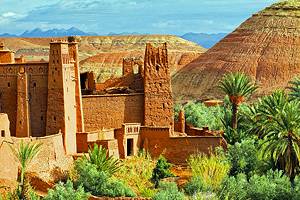
After Marrakesh: You can explore some of the most beautiful valleys and gorges of the High Atlas area on day trips from the city but to really delve into this vast region of snowcapped peaks, palm tree oases, and mudbrick kasbahs, take a journey into the High Atlas itself.
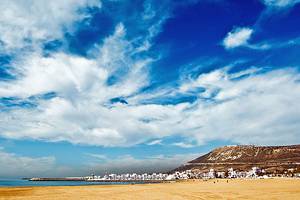
Head to the Coast: Head west to the Atlantic coast to check out some other Moroccan cities. Casablanca is a bustling city and home to the Hassan II Mosque. The capital, Rabat, has a medina perched right on the coast, and Agadir is Morocco's top beach break city, with a swathe of white sand.


